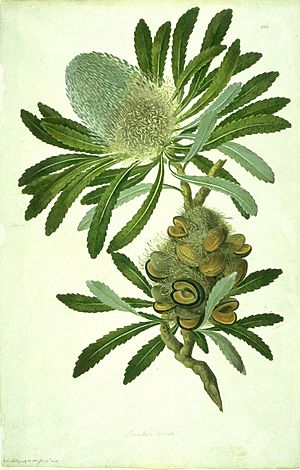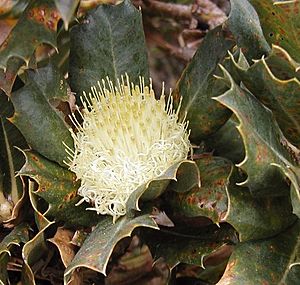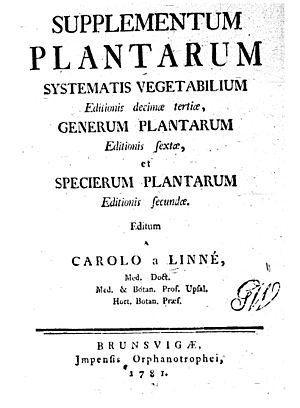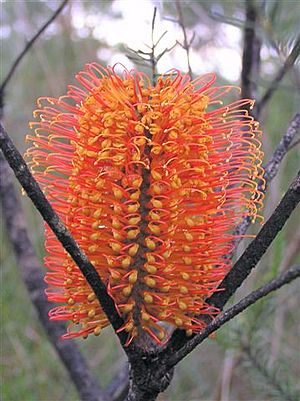Taxonomy of Banksia facts for kids

The taxonomy of Banksia is like a family tree for these amazing Australian plants. Scientists study their parts, like their flowers, fruiting structures, and seeds. They also look at their leaves and how they grow. More recently, scientists use DNA to understand how different Banksia species are related. This also helps them see how Banksia fits in with other plants in the Proteaceae family.
Banksia belongs to the plant family Proteaceae. It's part of a smaller group called Grevilleoideae and then an even smaller group called Banksieae. The most recent big study of Banksia was in 1999 by Alex George. He identified two main groups (subgenera), three sections, 13 series, 77 species, 6 subspecies, and 18 varieties. He also kept the related plant group Dryandra separate. However, newer DNA studies suggest that Dryandra should actually be part of Banksia. This idea has caused some debate among scientists.
Contents
Discovering Banksia
The first Banksia plants were collected by Sir Joseph Banks and Dr Daniel Solander. They were naturalists on Captain James Cook's ship, the Endeavour. Cook landed in Australia on April 29, 1770, at a place he later named Botany Bay. He chose this name because Banks and Solander found so many plants there.
Over the next seven weeks, Banks and Solander collected thousands of plants. Among them were the first samples of a new plant group. This group was later named Banksia to honor Sir Joseph Banks. They found four types of Banksia at Botany Bay:
- B. serrata (Saw Banksia)
- B. integrifolia (Coast Banksia)
- B. ericifolia (Heath-leaved Banksia)
- B. robur (Swamp Banksia)
Later, in June, they found B. dentata (Tropical Banksia) at the Endeavour River.
Every plant collected on the Endeavour trip was sketched by Sydney Parkinson, the botanical artist. When the ship returned to England in 1771, Banks's plants became part of his collection. Artists then painted watercolours based on Parkinson's sketches. Banks planned to publish all his findings, but it took ten years for any Banksia species to be officially described. By then, a sixth species, B. marginata (Silver Banksia), had been found in Tasmania in 1776.
Naming the Banksia Plants
The name Banksia was officially given by Carolus Linnaeus the Younger in April 1782. He named it after Joseph Banks. So, the full scientific name for the genus is "Banksia L.f.".
Interestingly, the name Banksia had actually been used before in 1775. It was used by J.R.Forst and G.Forst for some plants they found in New Zealand. But Linnaeus mistakenly thought those plants belonged to a different group called Passerina. Because of this, he thought the name Banksia was still available for the Australian plants.
Later, in 1788, Joseph Gaertner corrected this mistake. But by then, Banksia L.f. was already well-known. So, Gaertner renamed the New Zealand plants to Pimelea. This name had actually been chosen earlier by Banks and Solander.
Over the years, some scientists tried to change the name Banksia L.f. But these attempts failed. In 1940, it was officially decided that Banksia L.f. would remain the correct name.
How Scientists Group Banksia
In 1810, Robert Brown described 31 known Banksia species. He created a way to group them. He put B. ilicifolia into its own subgenus called Isostylis. This was because of its unusual dome-shaped flower cluster. All other species went into a subgenus called Banksia verae, meaning "True Banksias". Brown didn't try to classify them further.
Later, in 1847, Banksia verae was renamed Eubanksia by Stephan Endlicher. By 1856, there were 58 known Banksia species. Carl Meissner then divided Eubanksia into four series based on leaf features. However, these groups were not very clear.
In 1870, George Bentham published his own grouping of Banksia. He reduced the number of recognized species to 46. He replaced Meissner's groups with five sections. These sections were based on leaves, styles (part of the flower), and pollen. Three of these sections were clear and well-defined. But one, Orthostylis, was a bit mixed. The fifth section, Cyrtostylis, was created for species that didn't fit elsewhere, so it was very mixed. Despite its flaws, this grouping was used for over 100 years.
Banksia in the Plant Family Tree

Scientists like L. A. S. Johnson and Barbara Briggs helped create the main way to classify plants in the Proteaceae family. This system has been updated over time. The Proteaceae family has five main subfamilies. Banksia is in the Grevilleoideae subfamily because its flowers grow in pairs.
Based on leaf veins, hairs, and pollen, Banksia is grouped with three other plant types in a tribe called Banksieae. Two small groups, Austromuellera and Musgravea, are in a subtribe called Musgraveinae. Banksia is in the subtribe Banksiinae because its flowers grow in dense clusters.
Here's a simplified look at where Banksia fits:
- Family Proteaceae
- Subfamily Grevilleoideae
- Tribe Banksieae
- Subtribe Banksiinae
- Tribe Banksieae
- Subfamily Grevilleoideae
* Genus Banksia
For many years, scientists debated if Banksia and Dryandra should be separate groups. Some thought they should be combined because some Banksia species looked similar to Dryandra. However, Alex George argued that these similarities were only on the surface.
Recent DNA studies by Austin Mast showed that Dryandra is actually a subgroup within Banksia. This means that to make the plant family tree accurate, Dryandra should be included in Banksia. So, in 2007, all species that were once called Dryandra were moved into the Banksia genus.
Modern Banksia Grouping
In 1981, Alex George published an important book called The Genus Banksia L.f. (Proteaceae). His grouping was based on many features, including leaves, styles (parts of the flower), pollen, and seeds. He said a plant was a different species only if it had "important and consistent differences" in its flowers or fruit. This book became the main guide for Banksia for a long time.
George followed Robert Brown's idea of dividing Banksia into two subgenera: Banksia and Isostylis. He then divided the Banksia subgenus into two sections:
- Banksia for species with straight or slightly curved styles.
- Oncostylis for species with hooked styles.
These sections were then divided into smaller groups called series.
Here is a simplified overview of George's traditional grouping of Banksia:
* Subseries Acclives ** B. dentata – B. plagiocarpa – B. oblongifolia – B. robur * Subseries Integrifoliae ** B. aquilonia – B. integrifolia – B. conferta – B. paludosa – B. marginata – B. canei – B. saxicola
-
-
-
- Series Grandes
-
-
-
-
-
- Series Banksia
-
-
* Subseries Banksia ** B. serrata – B. aemula – B. ornata * Subseries Cratistylis ** B. baxteri – B. speciosa – B. menziesii – B. candolleana – B. sceptrum
-
-
-
- Series Crocinae
-
-
* B. prionotes – B. burdettii – B. hookeriana – B. victoriae
-
-
-
- Series Prostratae
-
-
* B. goodii – B. gardneri – B. chamaephyton – B. blechnifolia – B. repens – B. petiolaris
-
-
-
- Series Cyrtostylis
-
-
* B. media – B. praemorsa – B. epica – B. pilostylis – B. attenuata – B. ashbyi – B. benthamiana – B. audax – B. lullfitzii – B. elderiana – B. laevigata – B. elegans – B. lindleyana
-
-
-
- Series Tetragonae
-
-
* B. lemanniana – B. caleyi – B. aculeata
-
-
-
- Series Bauerinae
-
-
-
-
-
- Series Quercinae
-
-
* B. quercifolia – B. oreophila
-
-
- Section Coccinea
-
-
-
- Section Oncostylis
- Series Spicigerae
- Section Oncostylis
-
* Subseries Spinulosae ** B. spinulosa * Subseries Ericifoliae ** B. ericifolia * Subseries Occidentales ** B. verticillata – B. seminuda – B. littoralis – B. occidentalis – B. brownii
-
-
-
- Series Tricuspidae
-
-
-
-
-
- Series Dryandroidae
-
-
-
-
-
- Series Abietinae
-
-
* Subseries Nutantes ** B. nutans * Subseries Sphaerocarpae ** B. sphaerocarpa – B. micrantha – B. grossa * Subseries Leptophyllae ** B. telmatiaea – B. leptophylla – B. lanata – B. scabrella * Subseries Longistyles ** B. violacea – B. incana – B. laricina – B. pulchella – B. meisneri
-
- Subgenus Isostylis
* B. ilicifolia – B. oligantha – B. cuneata
New Ways to Classify Banksia
In 1996, Kevin Thiele and Pauline Ladiges used a method called cladistics to study Banksia. This method creates a "family tree" based on shared features. Their results were different from the old ways of grouping Banksia. So, they suggested a new way to classify the plants.
They suggested that four varieties should become full species:
- B. conferta var. penicillata became B. penicillata
- B. gardneri var. brevidentata became B. brevidentata
- B. gardneri var. hiemalis became B. hiemalis
- B. sphaerocarpa var. dolichostyla became B. dolichostyla
They also introduced new series and subseries. However, Alex George did not accept most of these changes in his 1999 revision. He said he used some new information from Thiele and Ladiges, but he didn't accept their new species or groups. Still, some plant collections in Australia continue to follow Thiele and Ladiges' ideas for these four species.



